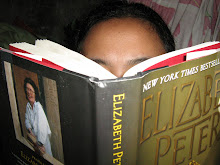Quality affordable condos in Manila
Now pre-selling units in Tower 5.
Studio (22.4 - 23.49 sq. m.) - P1.6M - P1.8M
1BR (39.36 - 40.73 sq. m.) - P2.9M - P3.3M
2BR (45.49 sq.m.) - P3.5M - P3.8M
Loft (39.85 - 66.83 sq. m.) - P3.2M - P5.1M
For inquiries please contact Eva at
(plus-six-three)-nine-two-one-six-one-two-four-five-three-three
or email mhie(underscore)bate22(at)yahoo(dot)com
25 October 2009
Contrary to what my mom would have you believe, I can actually cook rice. I just have to ask you first whether you are amenable to "malabsa" or moist rice. LOL.
I remember a scene from "Jewel in the Palace" where Jang Geum's mentor, Lady Han, has to compete against her best friend and worst rival, Lady Choi, for the position of "punong tagapamahala" or head administrator of the palace kitchens. The test was simple: cook rice. Everyone agreed that Lady Choi cooked a perfect pot of rice, but voted for Lady Han. Why?
Because Lady Han knew how everybody liked their rice, and so cooked according to individual tastes. She knew that some people like their rice moist almost like pudding, and some like their rice not so moist, but fluffy, while others actually liked the burned part at the bottom. And so she won.
My two roommates and I have different tastes in rice. Although we all agree that we like our rice fluffy and chewy, they both like their rice drier, while I like it moister. So when it's my turn to cook the rice, I get my portion first, then let the rice dry some more before serving theirs.
Yeah, yeah, how to cook rice? First wash your hands carefully.
1. Measure the rice into the pot. You may use a measuring cup for this; my mom just uses a clean medium-sized (around 370 ml) evaporated-milk can that she calls a "leche" (not a swear word, I assure you). Half a leche is good for one person; heavy eaters get one whole leche. So if you have like three women and a man in the house, that would be two and half milk cans. Pick out any noticeable pebbles or seeds.
2. Wash the rice by running water into the pot and stirring up the rice with your hands. My mom used to do this twice, until the water was clear, but now that she knows that rice bran is actually good for you, she now washes the rice only once and tries to keep the milky stuff. Carefully pour off the water including any chaff that would have floated to the top.
3. Put water into the pot. Theoretically, the amount of rice and water should be equal, i.e., two and a half milk cans of rice = two and a half milk cans of water. My mom measures the water level by dipping her hand into the pot and measuring the rice level, then the water level, with her knuckles. She then uses her hand to splash water in or out of the pot as needed. I always add a splash of water (heehee).
4. Put the pot on the fire, or if you're using a rice cooker, plug it in and punch the lever down to cook the rice. Put on the lid.
5. When the water starts to bubble up around the lid of the pot, lift the lid and place it askew on top so that the water will not boil over. It WILL boil over if you don't put the lid askew, no matter what you think to the contrary; if it doesn't, you probably haven't put in enough water.
6. Wait until the water has boiled off. That's when you open the lid and see that there's no longer any water in the pot, but cooked rice. However, it's still partly cooked rice that needs to be kept warm to finish cooking. If you're using a rice cooker, it's okay; the lever just pops to "warm" and you can put the lid on straight and let the rice stay at "warm" for about five to ten minutes before you unplug it.
If you're using a gas stove, turn the flame down low; if a wood or charcoal stove, scatter the coals a bit and let them burn down.
To know if the rice is thoroughly cooked, take a grain and bite through it. If it's soft all the way through, it's cooked; if you still see a hard white part in the center, it's not and you have to put it back on the fire. If it looks too dry, meaning you haven't put in enough water, you can just splash in like 50ml (about one finger thick at the bottom of a regular glass) and put it back on the fire to finish cooking. Make sure it's at warm, not cook, or you will end up burning the bottom part.
Okay, so why did something so simple end up so... complicated?
Labels: cooking
22 October 2009
It was my mom's lament... of her three children, I'm the one who never learned to cook. I don't know what ingredients go well together, or how to tell what's in a dish by merely smelling and tasting it. It's a pity because in our culture, the generic viand called "utan" or "tola" doesn't have a fixed recipe but is dictated by the availability of ingredients. Me, I need to have a recipe, or I'd forget ingredients or add the wrong one. Still, you might say I'm a "trying-hard" cook. I still keep experimenting... sometimes things taste good and sometimes they don't. LOL.
So here. I thought I'd start a blog about my attempts (and EPIC FAILS) at cooking.
Labels: cooking










